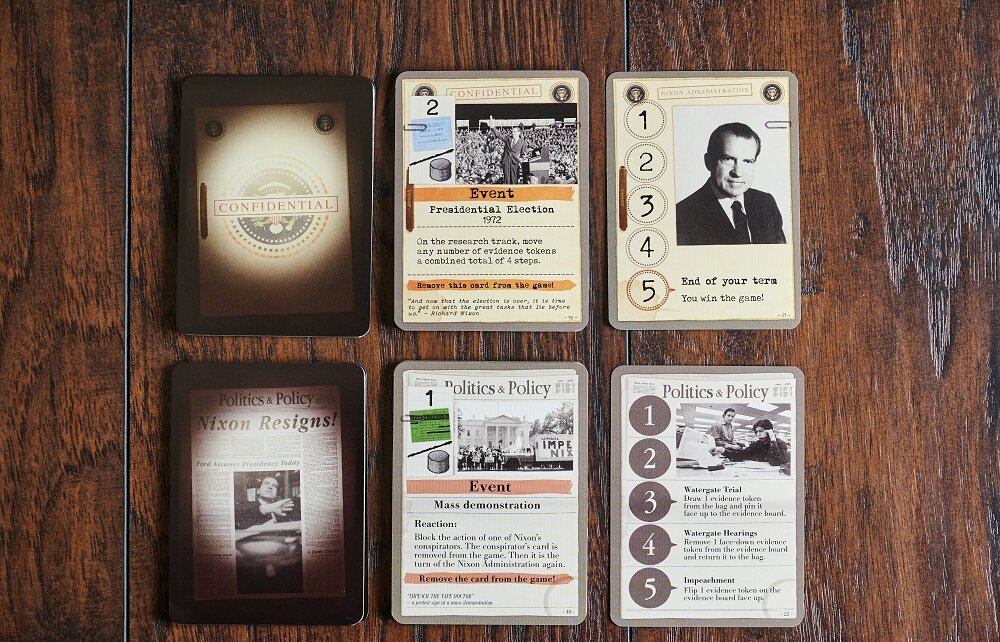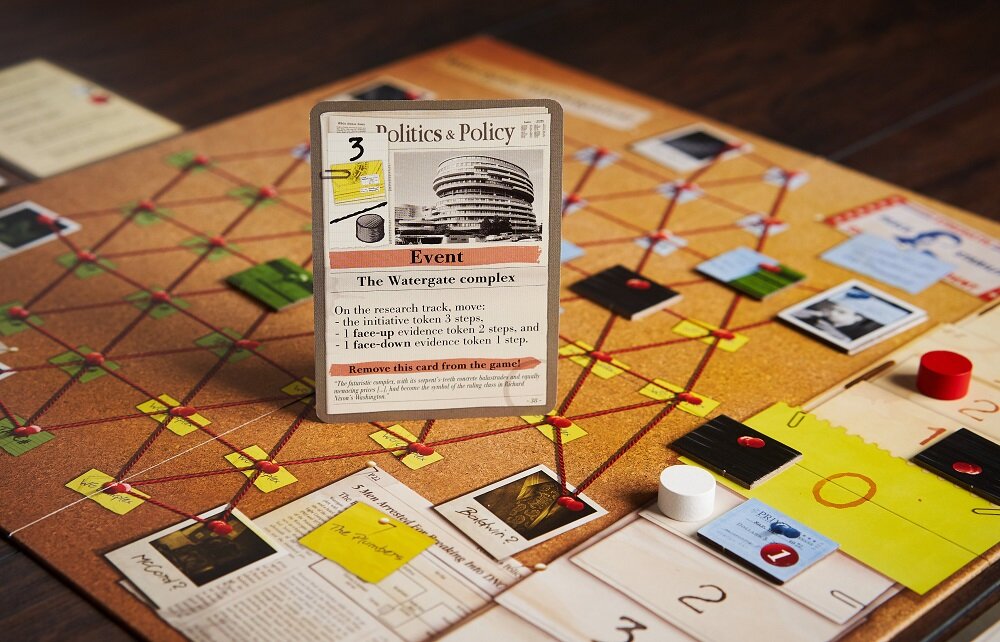From designer Matthias Cramer, Watergate is a two-player tug-of-war game that involves the scandal of the same name. One player represents the Nixon administration and tries to survive the political scandal by reaching the end of the presidential term. The other player represents The Washington Post and tries to connect informants in the Watergate scandal to Nixon and the presidency.
And all of it is brought to life by artists Klemens Franz and Alfred Viktor Schulz, who have constructed a visual feast of journalistic investigation, political web-building, and political maneuvering.
Published by Capstone Games and other partners in 2019, Watergate won the 2019 Golden Geek Award for Best 2-Player Board Game. It deserves that acclaim and recognition. The card game utilizes classic tug-of-war mechanics with player hands that can be used to perform actions or play events, but the two-player game finishes in about 30 minutes to an hour.
That short playtime, in addition to simple rules and elegant design, makes Watergate something special. I will likely not play Twilight Struggle anymore. What Watergate has done is simplify what makes that classic wargame so compelling and concentrate it into a smaller, more accessible package.
Let’s dive into Watergate and return to that infamous time in our political history.
STORY
In June 1972, five men are arrested in Washington’s Watergate building. What looks like a third-rate burglary attempt on the headquarters of the Democratic National Committee induces journalists Bob Woodward and Carl Bernstein of the Washington Post to start a thorough investigation. Over the following two years, they discover that the five men were directed from within the White House to spy on political opponents. As a consequence, in 1974 President Richard Nixon resigns from office to avoid impeachment.
Many gamers weren’t even born when this scandal upended American expectations for the presidency and uncovered the criminal actions of the Nixon administration.
What I really enjoyed about Watergate is the back half of the rulebook that contains biographies of all the people involved in the scandal as well as a detailed summary of events. While some players may never even read that latter portion of the rulebook, it’s a wonderful resource that provides context for the conspirators, journalists, and events of the game, as well as enhancing the immersion of the gameplay by constructing a historical background for the struggle between the editors of The Washington Post and the Nixon administration.
It’s an engrossing story and the conflict between the media and the executive office is just as relevant today, if not more so.
Matthias Cramer has taken a decades-old political event in U.S. history and transformed it into an exciting tabletop game.
GAMEPLAY
Watergate is not a difficult game to learn. I learned the rules within fifteen minutes, and I was able to teach it to other players within ten minutes.
And if you’re familiar with the tug-of-war mechanic present in popular wargames like Twilight Struggle or Churchill, then you would immediately understand the structure of the game.
Two players act as opposing sides, in this case the Nixon Administration and The Washington Post with each side trying to limit the other’s actions while pursuing their independent objectives. Nixon wants to coerce or silence possible informants while also covering up evidence that links him to the Watergate incident. The editors at The Washington Post want to utilize their journalists to recruit informants and connect trails of evidence that point to the presidency.
And each round involves playing either four or five cards on each side until both players have exhausted their hand of cards. At the end of that back-and-forth, players will resolve the end-of-round effects, namely the momentum and initiative tokens, as well as the evidence tokens that are brought out in the round.
Those tokens all have separate effects that are acted upon between rounds. The initiative token decides who will go first in the next round and also who will draw five cards instead of four. The momentum token is essential for Nixon’s victory. If he ever collects five tokens, the game is immediately over. The newspaper editors, though, can use it to enact some useful abilities.
Lastly, the evidence is used by either side, either to create trails of evidence between informants and Nixon or to obfuscate those trails.
That’s it.
The game board depicts the wall of possible connections between informants and Nixon, but all of the gameplay centers on the cards that the two players will use back and forth.
Single-use event cards with powerful ramifications; conspirators and journalists that interfere with the other player’s actions; and normal card play to manipulate and move the different tokens on the research track.
Writing all of that down takes much longer than just describing it in person. Two people could be playing this game within twenty minutes. It’s that fast. But it doesn’t sacrifice quality.
One of the biggest compliments that I could give Watergate is that it compresses all of the gameplay mechanics and tension that exists in Twilight Struggle into a sleek, simplified tabletop experience.
I don’t think I’ll play the classic again. Not with Watergate on my board game shelf. It plays faster. It plays smoother. There aren’t any complex or layered mathematical calculations that you have to account for. It’s just a fun game that extracts the best possible gameplay out of the tug-of-war system.
And games can come down to the wire.
In one of the two-player contests, I was playing as the Editor and Nixon had thwarted major plays of mine three turns in a row. There was only one round left. Even if Nixon didn’t take the momentum token at the end of the round, the empty supply of momentum tokens meant that he would win during the refresh phase. But I had managed to discover a way to win. With the initiative, I had five cards to Nixon’s four. If I saved my informant card to the very end, I could use all of my cards to bully the momentum token on my side and use the newspaper’s special ability to flip one last piece of evidence that Nixon had placed facedown. Then with my final move, I would recruit one of the informants and have my second complete trail of evidence.
The victory was within my grasp! But… it didn’t matter.
Nixon had one final trump card that I hadn’t seen before. And it auto-locked the momentum in the final spot on his side of the research track, which won him the game. My master plan was foiled. And my giddy internal celebration was cut short.
Such a satisfying and close end to the game, though. And the more you play, the more you are aware of the other player’s deck and the possible moves they could orchestrate.
It’s elegant. Watergate knocks it out of the park.
VISUALS
Watergate comes in a small box. The square cardboard contains the main cards and the two player decks. There is also a baggie for the tokens and a cloth bag for the evidence. Other than that, all you have is the board and the rulebook.
Not a lot there, and there doesn’t have to be.
The game board looks like the command center in a homicide case or newspaper investigation. The corkboard is littered with red strings, push pins, post-it notes, and other pieces of paper. On that board, informants and evidence will be connected as players put the small tokens on the board.
When small games create a big experience, I love it, and Watergate has achieved that. It’s more fun that other big-box games I own, and it takes up less real estate.
And the artwork from Klemens Franz and Alfred Viktor Schulz is great. It’s an unassuming black box filled with tabletop wonder.
REPLAYABILITY
So much replay value. Every game will go differently. The more you know the decks, the more you’ll be able to discover combinations of events and actions that can create advantages or wipe away the benefits of your opponent’s cards.
And the fast playtime means that you can keep enjoying it. Multiple times in one day or frequently over the course of months. It’s up to you.
But I know that I’ll be playing this for a long time.
WHAT IT COULD HAVE DONE BETTER
Once two experienced players have exhausted the two decks over the course of numerous games, they might feel like they’ve reached the zenith of potential in Watergate.
A later expansion with additional cards for the decks that maintain the historical accuracy of the game’s setting while adding new gameplay possibilities would be optimal.
For now, though, Watergate is doing everything right.
VERDICT
This is a fantastic two-player game. It deserves the awards. It deserves attention.
Watergate has conquered the tug-of-war mechanic and proven how great small-box games can be with a big heart. Buy it now. Play it soon. And good luck…whichever side you’re on.
























